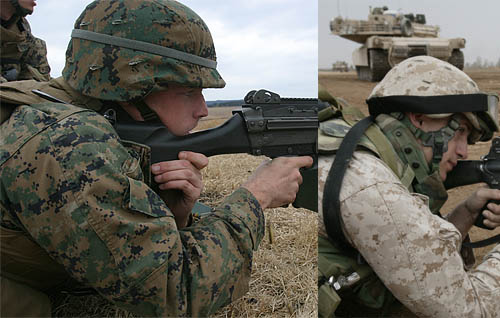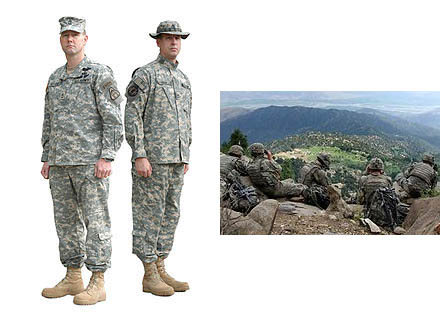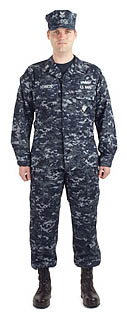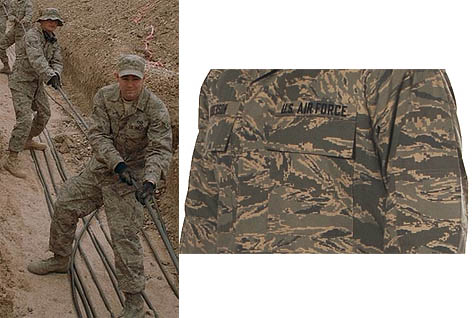Camouflage Patterns, US Military

In nature, there are strong needs for animals to blend into their environment or conceal their shape. To avoid predators and for predators to be able to sneak up on prey. Natural camouflage is a way that animals meet these needs. There are a number of methods of doing so. One is for the animal to blend in with its surroundings, while another is for the animal to disguise itself as something uninteresting or something dangerous.
The simplest way for an animal to camouflage is to be of a color similar to its surroundings. An example is the ‘earth tone’ color of deer or squirrels, or the bluish skin on the top of a shark versus the white underbelly which makes it difficult to detect from above and below.
More complex camouflage patterns are seen on lizards, frogs, and countless others, whose patterns have developed based on the environment in which they live.
So, what about humans? I guess you could say that we are various shades of earth tones. Other than our skin color though, we have the intellectual advantage to be able to wear just about any type of outerwear that we wish… giving us the ability to be able to blend in quite well with our surroundings.
The following is a list of some of the camouflage being used by various United States military.
UCP Camouflage (Army)

The Universal Camouflage Pattern (UCP), also referred to as ACUPAT (Army Combat Uniform PATtern) or Digital Camouflage (“digicam”), is currently used by the US Army. The basis for the UCP pattern was the Urban Track pattern, which had been modified through the removal of black from the pattern and digitized. The color black was omitted from the uniform because it is not commonly found in nature.
Multicam OCP Camouflage (Army, Special Ops)

MultiCam is a 7-color, multi-environment camouflage pattern under the designation OCP or Operation Enduring Freedom Camouflage Pattern. It is already used by some American Special Operations units and law enforcement agencies. It will be replacing the UCP pattern over time for use by US Army Units serving in Afghanistan. Multicam is a camouflage pattern developed by Crye Precision with the US Army Natick Soldier Research Center for the Army Combat Uniform program. It was designed to work in multiple environments, seasons, light levels and the IR spectrum.
Multicam colors (approximate – just a guess)
(Extrapolated using a color-picker while sampling the manufacturer website)

NWU Camouflage (Navy)

The Navy Working Uniform (NWU) uses a multi-color digital print pattern similar to those introduced by other services. However, the NWU is also made in three variants: predominately blue, with some gray, for the majority of sailors and shipboard use in addition to a woodland digital pattern and a desert digital pattern for sailors serving in units requiring those types of uniforms.
ABU Camouflage (Air Force)

The Airman Battle Uniform (ABU) is a service-distinctive camouflage battledress uniform for the United States Air Force. Modern digital and pixelated on 3 soft earth tones (tan, gray, and green) and slate blue tigerstripe pattern. It is currently in full production and will completely replace the Battle Dress Uniform at the end of Fiscal Year 2011.
MARPAT Camouflage (Marines)

MARPAT (short for MARine PATtern) is a digital camouflage pattern in use with the United States Marine Corps. It is also known as the “digital pattern” or “digi-cammies” because of its micropattern (pixels) rather than the old macropattern (big blobs). It comes in two variants – woodland and desert. It is a far more effective camouflage than standard uniform patterns because it mimics the dappled textures and rough boundaries found in natural settings. MARPAT is also important in that it identifies war-fighters as Marines to their enemies, while its camouflage simultaneously helps Marines to remain concealed.
If you enjoyed this, or topics of survival preparedness or current events risk awareness,
check out our current homepage articles…
